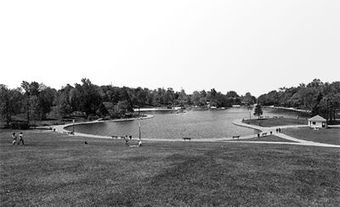John Wilmer Long
John Wilmer Long, "Jack," architect, community activist (b at Johnstown, Pennsylvania 12 Dec 1925; d at Vancouver 8 Feb 2001), was educated at Pennsylvania State University, graduating with a B.Arch in 1950. After graduation Long worked in New York, Philadelphia and Washington, DC, mainly on urban renewal projects and including a period with the firm of I.M. Pei (1955-60). In 1960 he moved to Calgary and in 1961 established a practice there. Initially he worked as a planning consultant with the City of Calgary. In 1964 he went into partnership with Hugh McMillan under the name McMillan, Long and Associates. In 1967 a Canada Mortgage and Housing Corporation grant allowed him to pursue Urban Studies at McGill University. He formed Jack Long and the New Street Group in 1970 and from 1974 to 1979 he practised as Long, Mayell and Associates. Long was active in professional and community organizations. In 1996 he retired from active practice.
The earliest phase of Long's career in Calgary focused primarily on residential design, and included the Roenisch residence (1963) and the Graham-Brown Residence (1963). Long also specialized in multi-family residential design, particularly for low income groups. Early examples include the Franklin House Apartments (1962) and the Kelvin Grove Patio Apartments (1964). The creation of McMillan, Long and Associates led to institutional work, including the Calgary Separate School Board building (1966) and the Calgary Remand Centre/Provincial Judges Court (1969). Other notable housing developments include Multi Family Housing (Forest Lawn, 1969), Rundle Lodge (Victoria Park, 1971) and Hillington Court in Edmonton (1972).
In 1966 the firm won a competition held for the Calgary Centennial Planetarium (1967). This building, constructed from exposed concrete and sculptural in its form, remains a fine example of the brutalist architecture popular across Canada during the 1960s. The New Street Group and Long, Mayell and Associates produced a number of notable projects, including the Master Plan for Wascana Centre in Regina (1969-73), the Agriculture Forestry Centre at the University of Alberta (1969) and the Roger's Pass Visitor Centre (1978).
During the 1960s Long became very involved in community activism, particularly in the working class Calgary neighbourhood of Inglewood. This commitment became a strong and distinguishing characteristic of his career as an architect. His thesis at McGill University (M Arch., 1973), "Everyman the Planner," shaped his ideas regarding community participation. With the creation of the New Street Group in the early 1970s he moved his practice into a historic Inglewood house and continued his involvement with numerous community causes. He served as a Calgary city alderman from 1980 to 1983.
Throughout his career Long won numerous awards, including several Canadian Housing Design Council Awards, two Design Canada Concrete Awards, a Canadian Architect Award (1969) and an Alberta Association of Architects Honours Contribution (1997).

 Share on Facebook
Share on Facebook Share on X
Share on X Share by Email
Share by Email Share on Google Classroom
Share on Google Classroom


